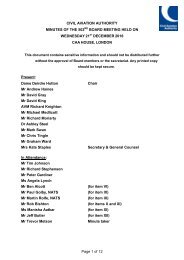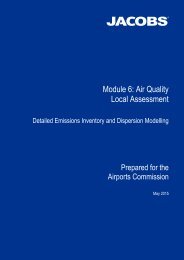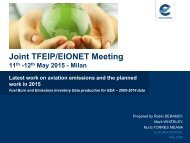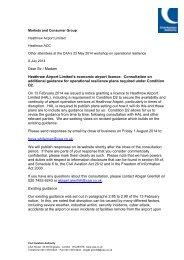NATS-Annual-Report-2015
NATS-Annual-Report-2015
NATS-Annual-Report-2015
You also want an ePaper? Increase the reach of your titles
YUMPU automatically turns print PDFs into web optimized ePapers that Google loves.
<strong>Annual</strong> <strong>Report</strong> and Accounts <strong>2015</strong> | <strong>NATS</strong> Holdings Limited<br />
Financial Statements 100<br />
Notes forming part of the<br />
consolidated accounts<br />
(continued)<br />
3. Critical judgements and key sources of<br />
estimation uncertainty<br />
Impairment of goodwill, intangible and tangible assets<br />
In carrying out impairment reviews of goodwill, intangible<br />
and tangible assets (including assets in the course of<br />
construction), a number of significant assumptions have<br />
to be made when preparing cash flow projections and<br />
assessing net realisable values. These include air traffic<br />
growth, service performance, future cash flows, the value of<br />
the regulated asset bases, market premiums for regulated<br />
businesses and the outcome of the regulatory price control<br />
determinations. The market premium was assessed at the<br />
balance sheet date to be 5-6% (2014: 7-8%). If the actual<br />
outcome should differ or changes in expectations arise,<br />
impairment charges may be required which would materially<br />
impact on operating results. Refer to notes 13, 14 and 15.<br />
Retirement benefits<br />
The group accounts for its defined benefit pension scheme<br />
such that the net pension scheme position is reported on<br />
the balance sheet with actuarial gains and losses being<br />
recognised directly in equity through the statement of<br />
comprehensive income.<br />
A number of key assumptions have been made<br />
in calculating the fair value of the group’s defined<br />
benefit pension scheme which affect the balance sheet<br />
position and the group’s reserves and income statement.<br />
Refer to note 28 of the notes to the consolidated<br />
accounts for a summary of the main assumptions and<br />
sensitivities. Actual outcomes may differ materially from<br />
the assumptions used and may result in volatility in the<br />
net pension scheme position.<br />
Recoverability of revenue allowances<br />
The economic regulatory price controls for UK en route<br />
services for Control Period 3 (2011 to 2014) and Reference<br />
Period 2 (<strong>2015</strong> to 2019) established an annual revenue<br />
allowance that is recovered through a price based on the<br />
economic regulator’s forecasts of traffic volumes and<br />
inflation made at the start of the price control period.<br />
Where traffic volumes or inflation differ from the regulator’s<br />
forecasts, revenue actually recovered may be higher or<br />
lower than the revenue allowance. Where this is the case,<br />
the EC Charging Regulation allows an adjustment to be<br />
made to the price two years later to reflect any over or<br />
under-recovery. Also, following the CP3 price control<br />
review, the economic regulator deferred the recovery of<br />
adjustments for traffic volume risk sharing and service<br />
performance incentives arising in the previous control<br />
period (CP2: 2006 to 2010) and allowed these to be<br />
recovered through an adjustment to prices in the last three<br />
years of CP3. The weakness of the economy in the early<br />
part of CP3 has resulted in traffic volumes which are lower<br />
than the regulator assumed for CP3. Inflation has also been<br />
higher than assumed. When combined with the remaining<br />
balances deferred from CP2 and service performance<br />
incentives from CP3, recoverable revenue allowances<br />
totalled £121.7m at 31 March <strong>2015</strong> (2014: £108.8m). The<br />
legal right to recover the revenue adjustments discussed<br />
above is provided by the EC Charging Regulation and<br />
NERL’s air traffic services licence. The group expects to<br />
recover these amounts through adjustments to prices in<br />
RP2.<br />
Capital investment programme<br />
The group is undertaking a significant capital investment<br />
programme to upgrade existing air traffic control<br />
infrastructure. This programme requires the group to<br />
enter into substantial contracts for the development of<br />
infrastructure assets and information systems. Whilst<br />
covered by contractual arrangements, it is in the nature of<br />
such complex projects that, from time to time, variations<br />
to the original specifications may necessitate the<br />
renegotiation of original contract scope or price and affect<br />
amounts reported in these accounts.<br />
Financial<br />
Statements






